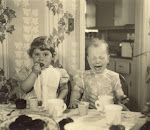475 Adelphi
Census records and old city directories reveal a lot of Brooklyn addresses for the Valentines and McNallys. People seem to have moved from one building to another just up the street, for example moving from 163 Adelphi Street to 225 Adelphi. Clinton Avenue
I asked Ben's sister Edie about it in 1986 and I recently found my notes from that conversation. She remembered it all quite vividly.
Ben (left) and friends in the 1920s
When she was young they moved every year because there were clauses in leases called concessions. If you would leave your apartment after one year's lease the [new] landlord would give you three months rent free. Grandma thought this a very good idea, so they "lived in every house on Pelham Parkway." My Dad and his brother Alec could pack the whole apartment in one night.
Edie and her mother, 1925
Edie and Ben were not the only New Yorkers who viewed that experience as a negative part of their childhood. Marion Meade who wrote a biography of Dorothy Parker noted that in the 19th century Parker's grandparents "lived modestly, perhaps even frugally. Since rents were low and concessions of a month or two free rent common, nearly every spring they would pile their household goods on a cart and shuttle the family to a new flat."
Columnist Walter Winchell also recalled frequent moves. His biographer Neal Gabler wrote: " The family was so poor that they were constantly on the move, presumable to dodge the rent collector or take advantage of the rent reductions that landlords often offered new tenants as an inducement."
The spring migration to a new apartment seems to have colored many New Yorkers' childhood memories of families that were not living in abject poverty, but were too close to its edge.
The back side of the row houses
"A Slum Brooklyn"












No comments:
Post a Comment